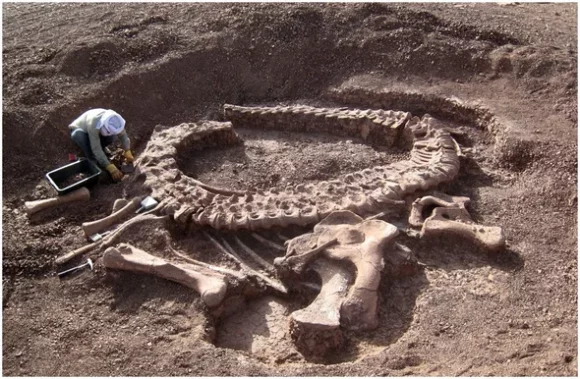Reading Riley Black’s The Last Days of the Dinosaurs for New Scientist, 20 April 2022
Welcome to Hell Creek, in what is now Montana. Readers had best not get too attached to the inhabitants dreamt into being in the first chapter of The Last Days of the Dinosaurs: the Tyrannosaurus rex, “her reddish brown hide now draped in orange and gold from the low-angled light of the evening sun”; the low-slung herbivore Ankylosaurus, defending herself with a tail club the size of a car tyre; the new-born Alamosaurus sanjuanensis chick, that will never get to grow into one of the largest animals to ever walk the Earth.
Tomorrow, a seven-mile-wide meteor will plough into the ancient Yucatán, triggering the extinction of around three quarters of all species on Earth. Along with all non-avian dinosaurs, great batwinged pterosaurs will perish; later, invertebrates like ammonites will stutter and stop in seas made corrosive by acid rain. Most early mammals — those that didn’t go up in flames, or get blasted off into outer space — will eventually starve; and with them, most lizards, snakes, and birds.
Subsequent chapters offer glimpses of the aftermath, each separated by an exponentially longer interval. An hour after impact and in Hell Creek, over 4,500 kilometres away from the impact, a puzzled Ankylosaurus fights for its footing at the edge of a trembling lake. Safe in her burrow, a squirrel-like Mesodma sleeps through a day of pulsing, planetary conflagration. A month in, and little two-toed Acheroraptors are poking about amongst the decaying debris, unaware of the cold and hunger to come.
Time accelerates. A year, a hundred years, a thousand years go by. We venture far from Hell Creek, many times, and learn much about dinosaurs and their long history, about the mechanisms of evolution and climate, and about the deep history of our planet. We learn to abandon old notions of a planet healing itself, or of life returning to some ideal degree of diversity. Mass extinctions are not “opportunities”, and when living designs are lost, in the great game of adaptation and extinction, they stay lost. Life got through by the skin of its teeth.
Hell Creek remains central throughout, as is only reasonable, since its geology appears to record in such extraordinary detail the events immediately following the giant Chicxulub asteroid’s impact. We glimpse it as an Eden, gardened by towering herbivores. We see it go up in flames. We say goodbye to the place as new plants smother and entangle it, creating the jungle environments from which complex behaviours and communities — both primate and avian — will be born. Throughout, the author’s shifting cast of characters remains vivid and charming.
Indeed, it’s as if Black — a palaeontologist and prolific writer, and no doubt familiar to many readers for her Laelaps blog — had set up camp in the very heart of the valley. This is palaeontology written with the immediacy of natural history.
In a long appendix, Black explains what’s real in this book, and what she’s made up. No need to be disconcerted. Without a leavening of intelligent speculation, palaeontologists have never been able to say anything useful. it’s a point Black makes splendidly, with reference to an illustrated study from 1863, The World Before the Deluge.
This book was published just a couple of years after the discovery of the first decent fossilised skeleton of Archaeopteryx — a previously missing link between reptiles and birds. The only problem was the head was missing. “Did Archaeopteryx have a beak? Teeth? Both? Neither? There was no way to answer the question,” Black explains. “And so The World Before the Deluge portrayed Archaeopteryx flying high above Jurassic conifers totally headless.”
Black’s approach is much more sensible, adding to The Last Days of the Dinosaurs whatever she needs — a head here, a behaviour there — to give us living, more-or-less reliable glimpses into the days after the worst day ever suffered by life on Earth.

